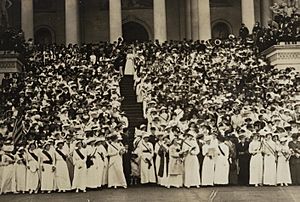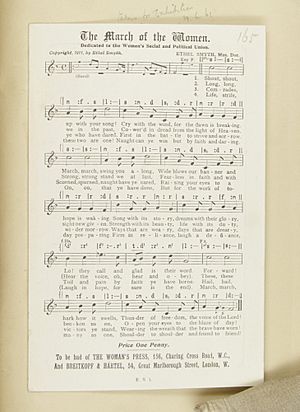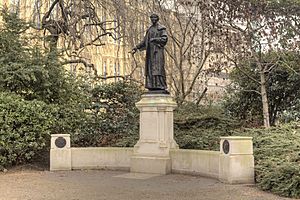The March of the Women facts for kids

"The March of the Women" is a powerful song written in 1910 by Ethel Smyth, with words by Cicely Hamilton. It became the official song for the Women's Social and Political Union (WSPU). This group worked hard to get women the right to vote. The song was sung by women fighting for their rights all over the United Kingdom and in other places too. They sang it at big meetings and even in prison as a way to protest.
Creating the Song
Ethel Smyth wrote "The March of the Women" in 1910. It was meant to be sung by many voices together, with an optional piano playing along. The words were written by Cicely Hamilton. Smyth got the idea for the song's tune from a traditional melody she heard in Abruzzo, Italy. She dedicated the song to the WSPU, showing her support for their cause. In January 1911, the WSPU's newspaper, Votes for Women, called the song "a hymn and a call to battle." This meant it was both a sacred song and an inspiring call to action.
When the Song Was Performed
The song "The March of the Women" was first sung on January 21, 1911. The Suffrage Choir performed it at a special event in London. This event celebrated the release of activists from prison. Emmeline Pankhurst, a leader of the WSPU, announced the song as the group's new official anthem. It took the place of an older song called "The Women's Marseillaise."
On March 23, 1911, the song was performed at a large meeting in the Royal Albert Hall. Emmeline Pankhurst gave Ethel Smyth a special stick called a baton. Smyth then used it to lead everyone in the hall in singing the song. Smyth worked hard to make sure the song was sung by WSPU members everywhere. It quickly became the main song for the women's right to vote movement across the United Kingdom.
A very famous performance happened in 1912 at Holloway Prison. Many women activists were put in prison after protesting by breaking windows. Ethel Smyth herself had broken the window of a government official. A conductor named Thomas Beecham visited Smyth in prison. He said he saw the activists in the prison yard. They were "...marching round it and singing lustily their war-chant." He also saw Smyth "beaming approbation from an overlooking upper window, beat time in almost Bacchic frenzy with a toothbrush." This shows how dedicated and spirited they were, even in prison.
In April 1913, Emmeline Pankhurst was in prison and started a hunger strike. This was a serious protest where she refused to eat. She told Smyth that at night she would quietly sing "The March of the Women." She also sang another song by Smyth called "Laggard Dawn."
Different Versions of the Song
Ethel Smyth made several different versions of her song. One version was for a choir with an optional orchestra. This version was part of a collection of three songs called Songs of Sunrise. These songs were first performed on April 1, 1911, in London.
In 1914, a version of "The March of the Women" for just a piano was published. It appeared in King Albert's Book. This book was sold to raise money for Belgian relief during a difficult time.
On March 6, 1930, Smyth conducted a version of the march for a military band. This was for the unveiling of a statue honoring Emmeline Pankhurst. The statue is in Victoria Tower Gardens. A politician named Stanley Baldwin was there for the ceremony. The band of the Metropolitan Police played the song.
The tune of "The March of the Women" can also be heard in the beginning music, called an overture, of Smyth's opera The Boatswain's Mate.
See also
 In Spanish: The March of the Women para niños
In Spanish: The March of the Women para niños



